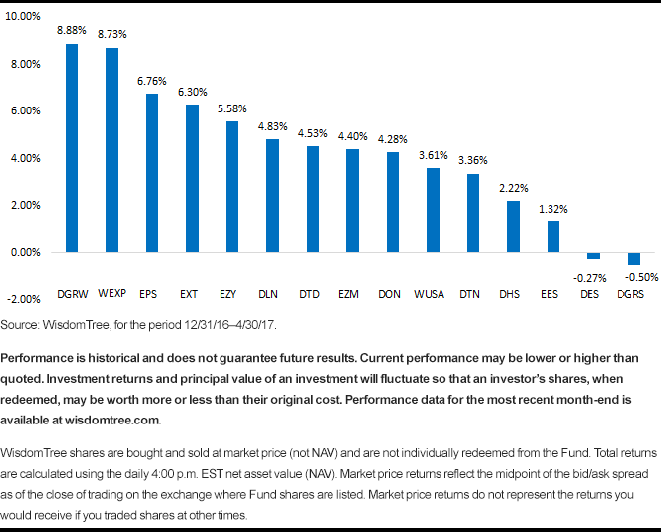Global Revenue: A Dominant Factor in Early 2017


For all the talk of President Trump’s efforts to “make America great again,” one of the most interesting features of the market in 2017 has been how the best performers across global equities have been anything focused internationally—whether emerging markets leading regions higher or even U.S. multinationals outperforming U.S.-focused market segments.
Click here for standardized performance of the Funds mentioned in the chart.
WisdomTree U.S.-Focused Equity Funds: YTD Performance as of 4/30/17

The chart above details the 2017 performance across all U.S.-focused WisdomTree equity exchange-traded funds (ETFs). Here’s what strikes me at first glance: the driving factor was that the more global the revenue base, the better the performance. This is illustrated by comparing three best-performing WisdomTree strategies to three worst-performing strategies through April 30, 2017.
- Global Revenue Factor: WisdomTree’s top-performing U.S. equity ETFs through the month of April focus on either U.S. export and multinational stocks or large-cap global-oriented stocks. The weighted average revenue of these stocks in the WisdomTree U.S. Export and Multinational Fund (WEXP) is predominantly foreign (approximately 60% revenue outside the U.S.), and this is WisdomTree’s most foreign-oriented basket of U.S. stocks, given the screens it employs to remove stocks focused on the U.S. economy. The top-performing Fund was a quality dividend growth ETF, the WisdomTree U.S. Quality Dividend Growth Fund (DGRW), which also has a relatively high share of revenue coming from a global basis because of sector concentrations that are under-weight in sectors including Utilities, Telecom, REITs, and Financials, all of which tend to be focused in U.S. markets. Its exposures in cyclical sectors—Consumer Discretionary, Technology, Industrials—are performing well, as is its Health Care exposure.
- Small-Cap Factor: WisdomTree’s three worst-performing U.S. equity ETFs were all centered on the U.S. small-cap market, and small caps tend to be the most sensitive to local economic prospects. After Trump’s election in November, small caps went on a big run through the end of the year. Their outperformance largely reversed in the first four months of 2017.
Global Revenue Base Trumping U.S. Rate Sensitivity in 2017
One of the key market forces in 2017 has been the absence of a grind higher in interest rates. The 10-Year bond started the year at 2.45% and was at 2.32% at the end of April.1
All other things being equal, a decline in interest rates should be supporting yield-sensitive assets over more growth-oriented assets. Although the move in rates has been modest overall on the year, at face value a decline in rates would have suggested to me support for our U.S. high-dividend ETF that focuses on the highest dividend-paying segment of the U.S. market. The high-dividend ETF is invested in more of what we call bond proxies, which respond more to declines in interest rates.
Yet while rates declined, our quality dividend growth ETF outperformed the high-dividend segment of the market by over 650 basis points (bps).2
We have talked about the valuation argument in the past—that is, how the quality dividend growth segment was priced at more attractive multiples—something I still believe to be true today.
But there’s no question that global businesses are attracting more interest over U.S.-focused companies in the first four months of 2017. This is reflected in the outperformance of developed international stocks over the U.S. markets and the outperformance of emerging markets over the U.S.
It speaks to a rebound in activity in many emerging markets—China, in particular—that is causing sentiment to improve on global growth.
Yes, there is the fading of the “Trump trades” and a reversal in performance post-election. But this outperformance also should show investors that global growth conditions are rather robust.
For those who want exposure to global growth without investing overseas, both the WisdomTree U.S. Export and Multinational Fund and the WisdomTree U.S. Quality Dividend Growth Fund are two interesting baskets to consider.
1Sources: WisdomTree, Bloomberg, as of 4/30/17.
2Refers specifically to the outperformance of DGRW relative to DHS for the period 12/31/16–4/30/17.
Important Risks Related to this Article
There are risks associated with investing, including possible loss of principal. Stocks that previously exhibited a positive correlation in equity performance to a weak U.S. dollar may not do so in the future, which could negatively impact Fund performance. A Fund that has exposure to one or more sectors may increase the Fund’s vulnerability to any single economic or regulatory development. This may result in greater share price volatility.
Dividends are not guaranteed, and a company currently paying dividends may cease paying dividends at any time.

Jeremy Schwartz has served as our Global Chief Investment Officer since November 2021 and leads WisdomTree’s investment strategy team in the construction of WisdomTree’s equity Indexes, quantitative active strategies and multi-asset Model Portfolios. Jeremy joined WisdomTree in May 2005 as a Senior Analyst, adding Deputy Director of Research to his responsibilities in February 2007. He served as Director of Research from October 2008 to October 2018 and as Global Head of Research from November 2018 to November 2021. Before joining WisdomTree, he was a head research assistant for Professor Jeremy Siegel and, in 2022, became his co-author on the sixth edition of the book Stocks for the Long Run. Jeremy is also co-author of the Financial Analysts Journal paper “What Happened to the Original Stocks in the S&P 500?” He received his B.S. in economics from The Wharton School of the University of Pennsylvania and hosts the Wharton Business Radio program Behind the Markets on SiriusXM 132. Jeremy is a member of the CFA Society of Philadelphia.

